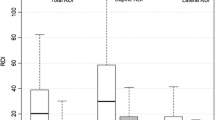Abstract
Obstructive sleep apnoea syndrome (OSAS) is a disorder characterized by recurrent episodes of apnoea. This study evaluates the body composition in OSAS patients compared to normal weight, pre-obese and obese subjects. Body composition has been measured by dual-energy X-ray absorptiometry in the whole body and in three different body regions. Abdominal region revealed no significant differences in fat mass percentage between patients and controls and no correlation between fat mass percentage and severity of OSAS. At the level of oral region, OSAS patients showed a significant decrease of fat free mass compared to control groups. At the level of neck region, OSAS patients showed a significant increase of fat mass compared to control groups and a significant correlation between the neck fat mass percentage and severity of OSAS. Regional fat distribution constitutes a risk factor for OSAS and a prognostic factor for severity of OSAS.







Similar content being viewed by others
References
O’Donnell CP, Schwartz AP, Smith PL (2000) Upper airway collapsibility. Am J Respir Crit Care Med 162:1606–1607
Wolk R, Shamsuzzaman AS, Somers VK (2003) Obesity, sleep apnoea and hypertension. Hypertension 42(6):1067–1074
Cistulli PA (1996) Craniofacial abnormalities in obstructive sleep apnoea: implications for treatment. Respirology 3:167–174
Jamieson A, Guilleminault C, Partinen M et al (1986) Obstructive sleep apnoeic patients have cranio-mandibular abnormalities. Sleep 9:469–477
Tangugsorn V, Skatvedt O, Krogstad O et al (1995) Obstructive sleep apnoea: a cephalometric study: Part II. Uvulo-glossopharyngeal morphology. Eur J Orthod 17:57–67
Yu X, Fujimoto K, Urushibata K et al (2003) Cephalometric analysis in obese and nonobese patients with obstructive sleep apnea syndrome. Chest 124:212–218
Busetto L, Enzi G, Inelmen EM et al (2005) Obstructive sleep apnea syndrome in morbid obesity: effects of intragastric baloon. Chest 128:618–623
Kyzer S, Charuzi I (1998) Obstructive sleep apnoea in obese. World J Surg 22:998–1001
Kansanen M, Vanninen E, Tuunainen A et al (1998) The effect of a very low-calorie diet-induced weight loss on the severity of obstructive sleep apnoea and autonomic nervous function in obese patients with obstructive sleep apnoea syndrome. Clin Physiol 18:377–385
Sampol G, Munoz X, Sagales MT et al (1998) Long-term efficacy of dietary weight loss in sleep apnoea/hypopnoea syndrome. Eur Respir J 18:377–385
Rollheim J, Osnes T, Miljeteig H (1997) The relationship between obstructive sleep apnoea and body mass index. Clin Otolaryngol 22:419–422
Whittle A, Marshall I, Mortimore I et al (1999) Neck soft tissue and fat distribution: comparison between normal men and women by magnetic resonance imaging. Thorax 54:323–328
Park Y-W, Heymsfield SB, Gallagher D (2002) Are dual-energy X-ray absorptiometry regional estimates associated with visceral adipose tissue mass? Int J Obes 26:978–983
Organization World Health (2000) Obesity: preventing and managing he global epidemic. WHO obesity technical report series 894, 2000. World Health Organization, Geneva
Mohsenin V (2001) Gender differences in the expression of sleep-disordered breathing: role of upper airway dimensions. Chest 120:1442–1447
Liistro G, Rombaux P, Belge C et al (2003) High mallampati score and nasal obstruction are associated risk factors for obstructive sleep apnoea. Eur Respir J 21(2):248–252
Schafer H, Pauleit D, Sudhop T et al (2002) Body fat distribution, serum leptin, and cardiovascular risk factors in men with obstructive sleep apnoea. Chest 122:829–839
Akita Y, Kawakatsu K, Hattori H et al (2003) Posture of patients with sleep apnoea during sleep. Acta otolaryngol 550:41–45
Nishimura Y, Nishimura T, Hattori H et al (2003) Obesity and obstructive sleep apnoea syndrome. Acta Otolaryngol Suppl 550:22–24
Lofaso F, Coste A, d’Ortho MP et al (2000) Nasal obstruction as a risk factor for sleep apnoea syndrome. Eur Respir J 16(4):639–643
Hoekema A, Hovinga B, Stegenga B et al (2003) Craniofacial morphology and obstructive sleep apnoea: a cephalometric analysis. J Oral Rehabil 30(7):690–696
Maiolo C, Mohamed EI, Andreoli A et al (2001) Is altered body fat distribution responsible for reduced pulmonary function in obese type 2 diabetic adult women? Diabetes Care 24:961–962
De Lorenzo A, Maiolo C, Mohamed EI et al (2001) Body composition analysis and changes in airways function in obese adults after hypocaloric diet. Chest 119:1409–1415
Mann EA, Burnett T, Cornell S et al (2002) The effect of neuromuscular stimulation of the genioglossus on the hypopharyngeal airway. Laryngoscope 112:351–356
Randerath WJ, Galetke W, Domanski U et al (2004) Tongue-muscle training by intraoral electrical neurostimulation in patients with obstructive sleep apnea. Sleep 27:254–259
Puhan M, Suarez A, Lo Cascio C et al (2006) Didgeridoo playing as alternative treatment for obstructive sleep apnoea syndrome: randomized controlled trial. British Medical Journal 332:266–270
Conflict of interest
The authors declare that they have no conflict of interest.
Author information
Authors and Affiliations
Corresponding author
Rights and permissions
About this article
Cite this article
Bruno, E., Alessandrini, M., Napolitano, B. et al. Dual-energy X-ray absorptiometry analysis of body composition in patients affected by OSAS. Eur Arch Otorhinolaryngol 266, 1285–1290 (2009). https://doi.org/10.1007/s00405-008-0844-0
Received:
Accepted:
Published:
Issue Date:
DOI: https://doi.org/10.1007/s00405-008-0844-0




